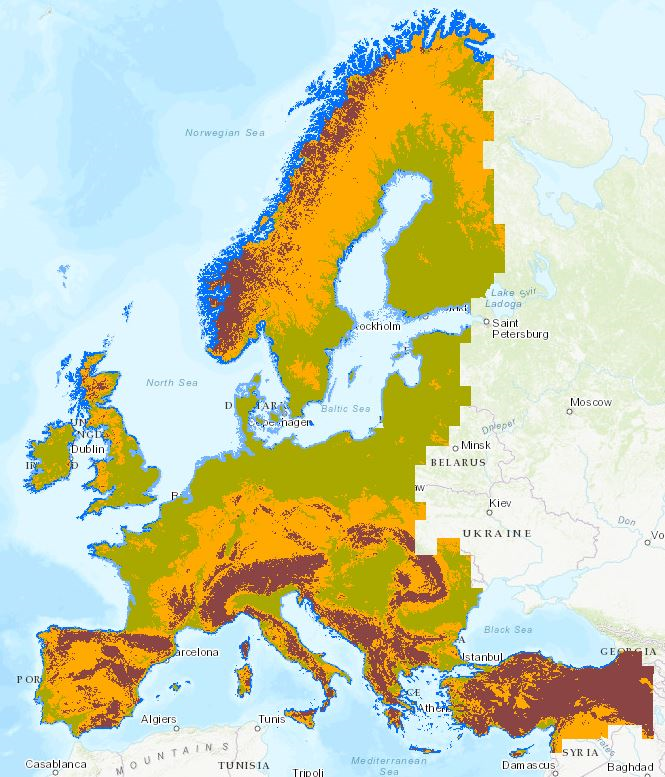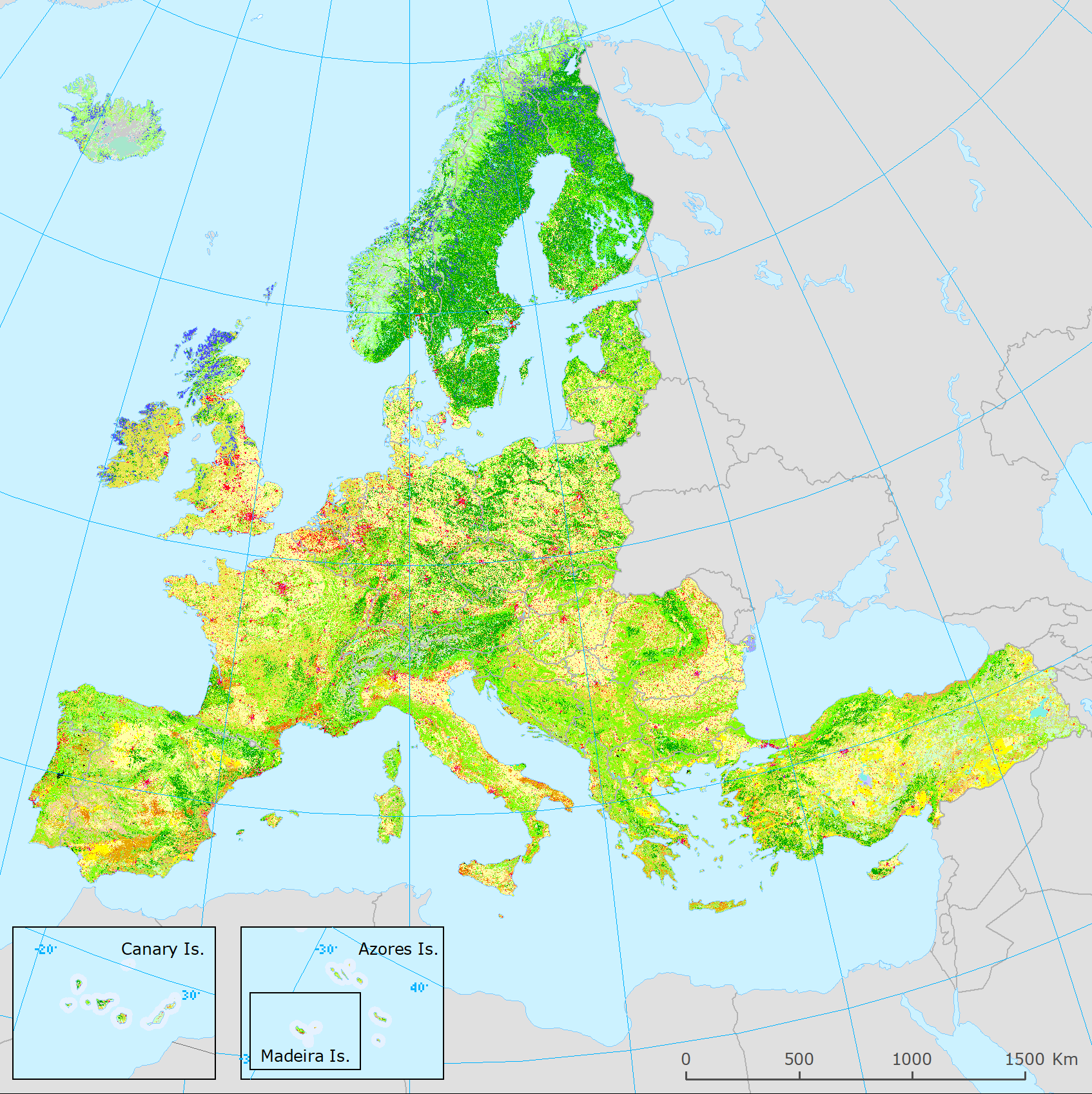LEAC
Type of resources
Available actions
Topics
INSPIRE themes
Keywords
Contact for the resource
Provided by
Years
Formats
Representation types
Update frequencies
status
Resolution
-

Land Cover Accounts are part of the Land and Ecosystem Accounting project which deal with data on changes in land cover and land use and seek to trace the wider environmental, social and economic implications of these transformations.
-

This dataset consists of the LandScan global population database of 2008 (grid in WGS84 with a 30" resolution) clipped to Europe and processed in order to match a LEAC grid (projection EPSG 3035 with a spatial resolution of 1km²). Content: population count per grid cell.
-

This layer defines homogeneous areas as function of height, slope and distance to the sea. The Elevation Breakdown is used to allocate Land Cover Changes into homogeneous areas as function of height, slope and distance to the sea. It defines five relief typologies: 1) Low coasts, 2) High Coasts, 3) Inlands, 4) Uplands and 4) Mountains. The previous enumeration corresponds to values in the grid.
-

Generalisation at 1 km resolution of elevation breakdown 100 m (based on EU-DEM). This layer defines homogeneous areas as function of height, slope and distance to the sea. The Elevation Breakdown is used to allocate Land Cover Changes into homogeneous areas as function of height, slope and distance to the sea. It defines five relief typologies: 1) Low coasts, 2) High Coasts, 3) Inlands, 4) Uplands and 4) Mountains. The previous enumeration corresponds to values in the grid.This layer is an updated version using similar methodology to the one created on 2006 (same classes and thresholds) but it has been generated using up-to-date high resolution datasets (EU-DEM) in order to create a more accurate layer.
-

The present 100m raster dataset is the 2018 CLC status layer modified for the purpose of consistent statistical analysis in the land cover change accounting system at EEA. CORINE Land Cover (CLC) data are produced from 1986 for European (EEA member or cooperating) countries. Altogether five mapping inventories were implemented in this period, producing five status layers (CLC1990, CLC2000, CLC2006, CLC2012, CLC2018) and four CLC-Change (CLCC) layers for the corresponding periods (1990-2000, 2000-2006, 2006-2012, 2012-2018). Pan-European CLC and CLCC data are available as vector and raster products. Due to the technical characteristics of CLC and CLCC data, the evolution in CLC update methodology and in quality of input data, time-series statistics derived directly from historical CLC data includes several inconsistencies. In order to create a statistically solid basis for CLC-based time series analysis, a harmonization methodology was elaborated.
-

CORINE Land Cover (CLC) data are produced from 1986 for European countries. Altogether four mapping inventories were implemented in this period, producing four status layers (CLC1990, CLC2000, CLC2006, CLC2012) and three CLC-change (CLCC) layers for three periods (1990-2000, 2000-2006, 2006-2012). To eliminate several inconsistencies from the usage of 100m raster version of original CLC data in the accounting systems at EEA, like Land and Ecosystem Accounting (LEAC), which uses a 1km grid (CUBE) base for calculation, a harmonization method were elaborated for the CLC and CLCC data. The applied solution for the harmonization combines CLC status and change layers in the 100m raster form in order to create homogeneous quality time series of CLC / CLC-change layers for accounting purposes. The so called "CLC accounting layers" fulfilling the relation: CLC-change = Modified CLC_ new status – Modified CLC old status. The modification method maximizes compatibility of “backdated” CLC status layers with CLC2012 and each other. However this simple solution causes several issues to be solved: (1) Modified CLC layers loose statistical comparability with original CLC layers, because of increased geometry; smaller than 25ha MMU features will appear locally where changes appear. In case of some CLC classes this causes significant differences. (2) “Fake features” are appearing in the backdated CLC status layers due to inconsistencies between CLC-change datasets. CLC2000 was the second CORINE Land Cover inventory and lasted for four years. Results of CLC1990 were improved and mapping CLC-Changes were tested. Computer Assisted Photo-Interpretation (CAPI) has become a commonplace. Number of participants has increased. CLC2000 was replaced by CLC2000_revised, if the country has produced this during the implementation of CLC2006 and delivered to EEA. If the CLC2000_revised layer did not exist for the country, the original CLC2000 was used in the final European mosaic.
-

CORINE Land Cover (CLC) data are produced from 1986 for European countries. Altogether four mapping inventories were implemented in this period, producing four status layers (CLC1990, CLC2000, CLC2006, CLC2012) and three CLC-change (CLCC) layers for three periods (1990-2000, 2000-2006, 2006-2012). To eliminate several inconsistencies from the usage of 100m raster version of original CLC data in the accounting systems at EEA, like Land and Ecosystem Accounting (LEAC), which uses a 1km grid (CUBE) base for calculation, a harmonization method were elaborated for the CLC and CLCC data. The applied solution for the harmonization combines CLC status and change layers in the 100m raster form in order to create homogeneous quality time series of CLC / CLC-change layers for accounting purposes. The so called "CLC accounting layers" fulfilling the relation: CLC-change = Modified CLC_ new status – Modified CLC old status. The modification method maximizes compatibility of “backdated” CLC status layers with CLC2012 and each other. However this simple solution causes several issues to be solved: (1) Modified CLC layers loose statistical comparability with original CLC layers, because of increased geometry; smaller than 25ha MMU features will appear locally where changes appear. In case of some CLC classes this causes significant differences. (2) “Fake features” are appearing in the backdated CLC status layers due to inconsistencies between CLC-change datasets. CLC2012 is the fourth CORINE Land Cover inventory and took three years to finalize. A dual coverage of satellite images were used. Computer Assisted Photo-Interpretation (CAPI) was the dominating mapping technology. The number of countries using advanced (bottom-up) solutions has slightly increased. All of the EEA39 countries have participated within the official lifetime of the project.
-

CORINE Land Cover (CLC) data are produced from 1986 for European countries. Altogether four mapping inventories were implemented in this period, producing four status layers (CLC1990, CLC2000, CLC2006, CLC2012) and three CLC-change (CLCC) layers for three periods (1990-2000, 2000-2006, 2006-2012). To eliminate several inconsistencies from the usage of 100m raster version of original CLC data in the accounting systems at EEA, like Land and Ecosystem Accounting (LEAC), which uses a 1km grid (CUBE) base for calculation, a harmonization method were elaborated for the CLC and CLCC data. The applied solution for the harmonization combines CLC status and change layers in the 100m raster form in order to create homogeneous quality time series of CLC / CLC-change layers for accounting purposes. The so called "CLC accounting layers" fulfilling the relation: CLC-change = Modified CLC_ new status – Modified CLC old status. The modification method maximizes compatibility of “backdated” CLC status layers with CLC2012 and each other. However this simple solution causes several issues to be solved: (1) Modified CLC layers loose statistical comparability with original CLC layers, because of increased geometry; smaller than 25ha MMU features will appear locally where changes appear. In case of some CLC classes this causes significant differences. (2) “Fake features” are appearing in the backdated CLC status layers due to inconsistencies between CLC-change datasets. CLC2006 was the third CORINE Land Cover inventory and needed three years to be accomplished. Instead of a single imagery, a dual coverage of satellite images were used. The methodology of mapping changes was consolidated. Dominating mapping technology was the Computer Assisted Photo-Interpretation (CAPI). Advanced (less human work intensive) solutions appeared in some countries. All but one of the EEA39 countries have participated within the official lifetime of the project. Greece accomplished CLC2006 later, at the time of the CLC2012. CLC2006 was replaced by CLC2006_revised, if the country has produced this during the implementation of CLC2012 and delivered to EEA. If the CLC2006_revised layer did not exist for the country, the original CLC2006 was used in the final European mosaic.
-

The present 100m raster dataset is the 2000 CLC status layer modified for the purpose of consistent statistical analysis in the land cover change accounting system at EEA. CORINE Land Cover (CLC) data are produced from 1986 for European (EEA member or cooperating) countries. Altogether five mapping inventories were implemented in this period, producing five status layers (CLC1990, CLC2000, CLC2006, CLC2012, CLC2018) and four CLC-Change (CLCC) layers for the corresponding periods (1990-2000, 2000-2006, 2006-2012, 2012-2018). Pan-European CLC and CLCC data are available as vector and raster products. Due to the technical characteristics of CLC and CLCC data, the evolution in CLC update methodology and in quality of input data, time-series statistics derived directly from historical CLC data includes several inconsistencies. In order to create a statistically solid basis for CLC-based time series analysis, a harmonization methodology was elaborated.
-

The LEAC mask at 1 km x 1 km is a dataset derived from CLC2012 used as the reference mask for accounting purposes within the EEA. It is a mask where all 1 km x 1 km cells (in line with the European reference Grid) with any valid land cover class value in CLC2012, except for class 523 - Sea and ocean, get a value of "1". The rest of pixels get a "0". In other words, land areas with CLC2012 data are identified with the value "1", whereas sea areas and areas with no CLC2012 data available get a value of "0".
 RUC Geo-Data catalogue
RUC Geo-Data catalogue